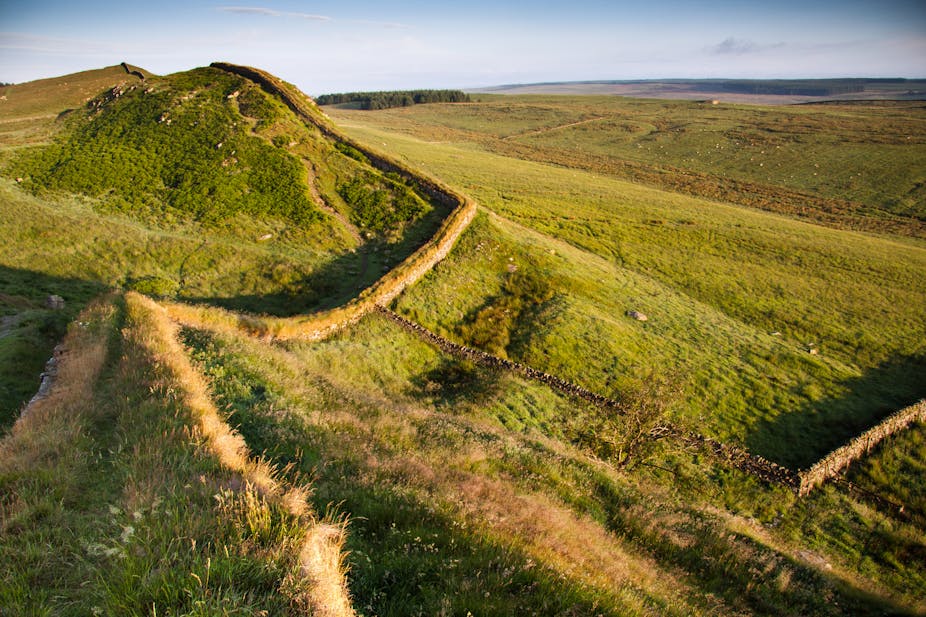The Scottish referendum has caused the ancient Roman frontier of Hadrian’s Wall to take on new significance, and is inspiring both those who support and oppose independence. This was particularly seen in a jovial fashion on April 1, when there appeared a number of April fool’s stories that targeted the topic of an independent Scotland.
Typical of these was an article with the headline Secret Plan to rebuild Hadrian’s Wall that appeared on the Building Design website. The piece describes a leaked secret plan to rebuild this Roman monument were Scotland to win this autumn’s vote. It mentions that this would involve rebuilding “the crumbling Roman wall” to its original proportions in order to create an “imposing barrier” between Scotland and England. It also describes glass gatehouses that would be constructed every ten miles with an immigration officer and a customs official. Then, rinsing the joke for all it’s worth, the article describes the design of this new Wall – based on the facade of the Scottish parliament. It’s unclear, they say, whether the plan was drawn up in Scotland or England.
But it’s not only jokes that have referenced the idea of rebuilding Hadrian’s Wall. On February 6 2012, the Mail on Sunday included a similar news item – in sincerity, this time. “Hadrian’s Wall” customs if Scotland goes it alone to stop illegal migrants flooding into England, trumpeted the headline. The author argued that a Hadrian’s Wall-style border might have to be built if Scotland gets independence – to stop illegal migrants flooding into England. This concern is related to a Foreign Office memo which is said to have been leaked to the paper. The report supposedly considered an independent Scotland would be required to join the Schengen open-borders system used by 25 European states, which Britain has opted out of.
So it’s evident that Hadrian’s Wall is very closely identified as the border that divides England and Scotland. Unfortunately for jokers and scaremongers, the Roman structure actually lies some way to the south of this line.
The wall was constructed in the AD 120s and appears to have been in use until the early fifth century AD. It had been out of use for many centuries when the independent kingdoms of England and Scotland came to be defined. The national border crystallised in its current location some way to the north of the wall during the 10th to 12th centuries.

There was no Scotland or England when the wall was in use. And since Scotland and England did not exist in Roman times and Hadrian’s Wall isn’t located on the line of the border, it’s interesting to consider why this ancient structure is being tugged into news reports and speculation by so many.
The substantial physical remains of Hadrian’s Wall appear to have been well preserved in the central upland sections until the 16th century. It lay within the “debatable lands” across the borders between the two medieval kingdoms, territories that were not under the direct political control of either. England lay mainly to the south of the wall and, as a result, the English have often laid claim to the Roman inheritance.
Ideas of rebuilding the wall are far from new. When there has been any conflict or friction between the people to the north and south of the frontier the question has arisen. In the 1580s, for example, a proposal was made to Queen Elizabeth to construct a new frontier along the English-Scottish border, a physical wall that was evidently informed by the remains of the Roman Wall. And in the 1750s, in the aftermath of the “Jacobite Rebellion” and the battle of Culloden, the government built a military road along the course of the wall which was seen by some as a “re-edification” of Roman border order.
At other times, the concept of the wall’s disuse and dilapidation has proved much more influential, and it has often been used as a metaphor to emphasise the ways that people have co-operated across the line of the ancient frontier. So we can expect the media to reference the wall’s ruination if people in Scotland vote against independence in September.
People draw this association because Hadrian’s Wall is so well known, so substantial and so ancient. But it’s worth remembering that what it actually represents is a conflict of cultures far older and wider than the questions of the referendum can ever lay claim to.
Regardless of the way the vote goes we can expect to hear more about Hadrian. Hopefully this will all be in a fairly lighthearted fashion. I wonder how much of Newcastle would react at the idea of a refortified wall? Much of the city would find itself in Scotland.

